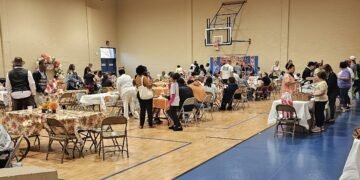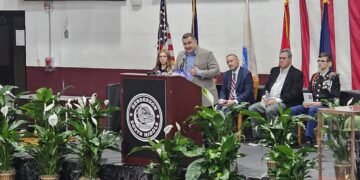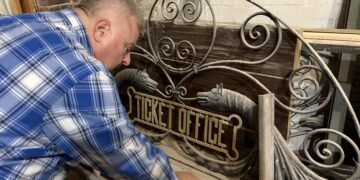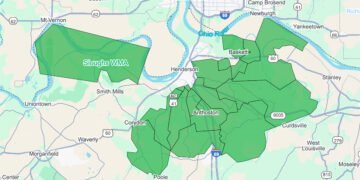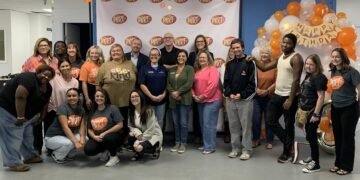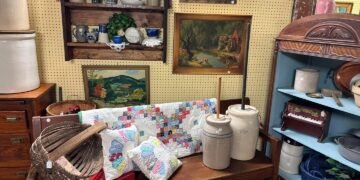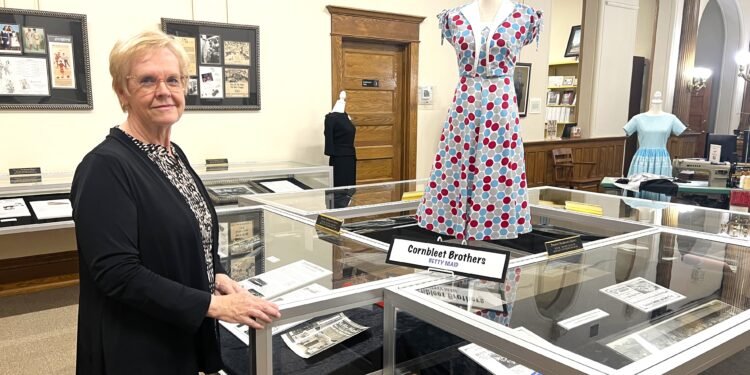(This article first appeared in the December print edition of the Hendersonian.)
The clothes on your back more than likely were manufactured in Asia, probably China.
But there was a time when Americans wore clothes mostly made in America. And a substantial amount of those clothes—especially women’s dresses and socks—were produced in Henderson.
The apparel industry here once employed hundreds, even 1,000 or more. Dresses designed and sewn here were sold across the country. Their brands were advertised in national fashion magazines. And Henderson women could buy some dresses straight from the factory.
Memories of those times are fading. Two generations have passed since the last dress factory here closed.
But thanks to a special exhibit at the Henderson County Public Library, there’s an opportunity to learn about the once-vast apparel industry here.
Titled “Made in Henderson,” the exhibit is the product of Donna Spencer, a genealogy and local history associate at the library, and Greg Gibson and Vera Beth Cornbleet, descendants of owners of two of the biggest dress factories here.
The exhibit, which fills nine display cases in addition to stand-alone items, includes photos, newspaper articles, artifacts and even some original dresses that were made here and found online. It will remain up through December.
Among the artifacts on display is a vintage sewing machine. “There have been young kids come up and say, ‘What is that?’” Spencer said.
Industrial-scale textile and apparel production got its start here with the opening of the Henderson Woolen Mills at the northeast corner of Third and Water streets in 1883, employing 140 workers producing cloth that was used locally and sold across the nation.
In 1886, the mill added 50 women and girls who produced 240 pairs of Kentucky Jeans each week. But a fire in 1904 destroyed the main building and ended the enterprise.
The Henderson Cotton Mills began production in 1885 in a three-story, two-block-long brick building in the 1300 block of Washington Street. It quickly became the city’s largest single industry, employing more than 200 men, women and children running looms and spindles to produce fine cotton sheeting that was sold from Cincinnati to San Francisco.
The cotton mill closed during the Great Depression but was reopened in 1937 by Bear Brand Hosiery to produce socks. At its busiest, Bear Brand employed about 1,000 people and was Henderson’s largest employer in 1963, producing 35,000 dozen pairs of men’s and children’s socks every week.
When Bear Brand closed the plant in 1969, it was acquired by former manager Elmer Korth, who renamed it Audubon Hosiery and produced work socks for large chain stores such as J.C. Penney until closing in 1982. The immense building was demolished two years later.
The Cornbleet brothers—Benjamin and Richard—built a company making dresses at plants in Illinois. Needing more production capacity, the Cornbleets in 1935 opened a small plant at the corner of First and Ingram streets here, producing cotton dresses that were sold for $1.
With business booming, it needed more space; the city, the federal WPA program and the Cornbleets put up money to erect a new building in 1936 on South Water Street that employed 100 people.
As the U.S. slowly recovered from the Depression, the Cornbleets produced more stylish dresses under the Betty Maid label that were sold at Betty Maid stores stretching coast to coast.
“I didn’t realize how many stores we had in the United States—over 100—and one of the first air-conditioned stores in Hollywood,” Vera Beth Cornbleet said.
As the Cornbleet brothers scaled back their careers, the Water Street plant in 1951 was converted to Dixie Lou Frocks, which sold dresses in 27 states and operated until 1975.
But some of their employees set out on their own.
Veteran Cornbleet dress designers Ernestine Seitz—who got her start as a teenager running looms at the hosiery mill—and Frank Cusic, along with a third partner, founded the C.B.S. Dress Co. in a three-story former tobacco plant at Third and Water. Eventually Seitz became the sole proprietor.
Her company “had as many as 300 employees in that (former) tobacco warehouse, from the cutting floor to the sewing floor to the seaming area to shipping to administrative,” Gibson said, who grew up playing in the factory. She advertised her C.B.S. sportswear apparel in Seventeen magazine and her Marta ’D label in Mademoiselle.
“I put my grandmother on a pedestal because she was a woman ahead of her time,” Gibson said.
Yet another enterprise here was Edythe’s Fashion and Fabrics on Franklin Street. Edythe Waggner, a former Cornbleet dress designer, attended fashion shows in New York for inspiration for designs she sketched for the Edda label that was sold by J.C. Penney.
Dressmaking ended here in 1979, when C.B.S. was forced to close because of fire code violations in the old building.

